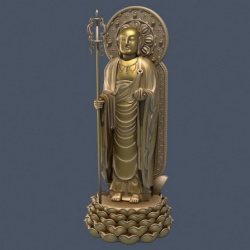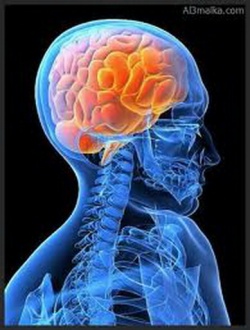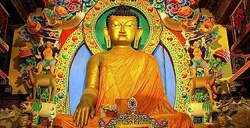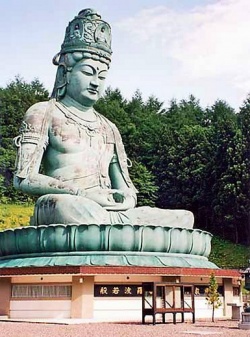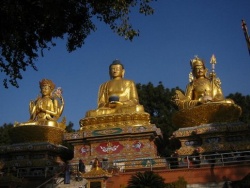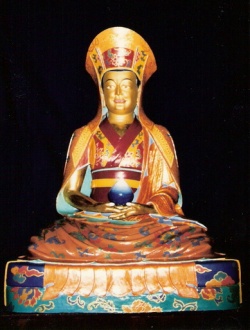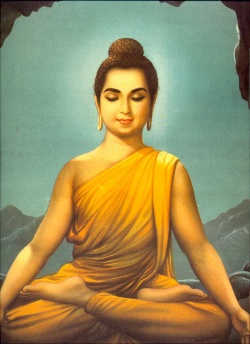Tuerin monastery
The secret of the Tuerin monastery was mentioned for the first time in the Adventure magazine in 1922. Traveler William Thompson was describing there an odd episode that happened to him in 1920 when he was in Mongolia. While touring the Tuerin monastery he met with a gun and drug dealer John Spencer who was on a run from Manchuria to Tibet. The Lamas found him and took care of him when he felt unconscious in a fever on a path leading to their monastery. When Spencer started feeling a little better he showed a great interest in the monastery and its surroundings.
One day as he was walking near the monastery he discovered a hidden rotten staircase that lead somewhere under the ground. Without much effort he opened a little metal door at the end of the staircase and found himself in a room of an unusual shape which had perhaps twelve or thirteen walls. Each wall carried a painting with some of them representing the signs of zodiac. Spencer recognized Taurus, his zodiac sign. In deep pondering over what he was seeing his fingers were thoughtlessly copying shapes on the walls and at one point, he late remember it was when he touched the Pleiades he felt as if the wall began moving. It did indeed and showed an entrance to a corridor. Spencer stepped into the tunnel that appeared behind the wall, it was illuminated with feeble green light coming right out of the walls and the ceiling.
As he walked through the corridor he saw paths split off, however he stayed on what seemed to be the main one and after a while it brought him to a room with brighter light. Along the wall of the room he saw thirteen coffins that were floating above the ground, maybe some half a meter high. He curiously began lifting lids of the coffins and saw that three of them carried bodies of monks and the others contained bodies of men and women in well preserved clothes that belonged to deep history. The body in the last coffin however was different, it was an unknown being dressed in something silver. The being had a silver ball instead of a head with round holes for eyes and with a "thing" sticking out instead of a nose with little holes for nostrils. And It didn't have a mouth. Spencer, shocked as he was, wanted to touch the strange being but as he stretched his arm the eyes of the monster widely opened and a green light shot out of them. Spencer dropped the lid of the coffin and ran out of the underground as fast as he could.
He tried to tell one of the lamas about what he saw but the lama blamed it on Spencer's imagination exaggerated by fever. However he yielded to Spencer's pleading and went to the underground with him. They walked through a short corridor which ended with a small room with an altar. On a shelf by one of the walls there were 13 little coffins about 12 centimeters long with little figures inside of them that looked like perfect copies of the bodies Spencer had seen the first time.
"What you really saw was this," the lama said smiling. "They are models of personalities that enriched this country with their wisdom and who we worship. The last one with the silver head is Great Master who came down from the stars." Then lama pointed at a painting above the altar and Spencer noticed that it was again Taurus with Pleiades.
When Spencer met with Thompson he tried to explain to him that he had suffered no hallucinations when he had walked through the underground and that he really saw what he saw. Thompson wrote in his story that Spencer kept on repeating that the lama purposely took him to a different corridor to confuse him. He said he had seen the lama to open a wall right opposite the entrance while the wall with the Plejadas that had opened for Spencer had been to the left. Spencer probably paid for his discovery with his life because according to Thompson's story he disappeared shortly after meeting with Thompson and no one ever saw him again.
Czech explorer Ivan Mackerle wrote this in his search for the tomb(he mentions Agartha and C's said it's a fiction):
Is everything a lie or just a fantasy? The story though happened at a time when no one was talking about extraterrestrial. Erich von Daniken came with his hypothesis about extraterrestrial bringing intelligent life on Earth much later. Does it mean that the underground of the monastery holds a remainder of an alien or is it an entrance to the Underground Agharti Kingdom? According to an old Buddha legend, the Aghartians were a peaceful nation lead by a holy person Rygden Jyepo - the Ruler of the World. Others say that Aghartians were the Biblical sons of God, perhaps visitors from the space who hid under the Earth's ground after a disaster that had happened many thousands of years ago. Supposedly they wear silver suits and live in underground tunnels where they travel on special flying machines called vimanas that are run by a power called vril. And the tunnels are lid by luminescent light of green color. The legend says that the flying machines from time to time appear above the ground as the Aghartians maintain contact with chosen humans. Some travelers at the beginning of this century mentioned unknown flying objects in Mongolia. Ferdinand Ossendowski describes in his book Beast, Men and Gods (1923) "vehicles absolutely unknown, flying above sky-high peaks and descending in the depths of Earth." Nicholas Roerich in his book Heart of Asia (1928) writes about "objects of a round shape with shiny surface appearing above Mongolia."
During my trip to Mongolia in 1990 I was determined to find the Tuerin monastery and to research its underground. I knew that the lamas and keepers of mysteries carefully guarded their secret. But I knew that by now monasteries had been surely in ruins and deserted for a long time. That was the destiny of all monasteries in Mongolia after the Communists seized the power in the 30Os. So I expected to find no one guarding in the ruins.
I ran to a problem though. It was impossible for me to find out where the Tuerin monastery used to be as no available map of Mongolia carried such a name, nor did any list of old Mongolia monasteries. However, after studying old travel books about Mongolia, I found out that the monastery used to be on an old trade road going from Urga (today's Ulanbatar) to Beijing and that the place was about 130 kilometers away from Urga. It used to be by a telegraph station and at a bottom of some rocky mountains. So with my friends we traveled across the country, climbed deserted ruins and inquired in local villages and nomad dwellings.
Statuette of mysterious strangers in silver suits with round head really used to be worshiped in the underground of the Tuerin monastery and not only there. Everywhere where, according to the legend, used to be cities of the gods from stars and where underground tunnels had their beginnings.
If you are lucky you can find those figures on the black market these days. I was offered one by a young man who was secretly trading antiquities and minerals which were banned for exporting. The statuette was in a paper box among figures of traditional silver and bras lamaistic gods called burchans that were lifted out of ruins of many monasteries. The figure which was some 10 centimeters long distinguished itself from the other ones. The shapes were smoothed down by centuries, as the figure was surely clutched by generations of hands. It had the round head with holes instead of eyes and where the head was adjusted to the body it was symbolized by a ring, sort of like a diving and space suit. Arms were pressed against the chest and held some sort of sickle-like-subject that resembled a driving wheel. Stomach of the figure carried an illegible symbol in Tibetan language or something that UFO believers might have identified as a modern electric device. I held it in my hands for a long time and carefully looked at it. Unfortunately I didn't have enough money to buy it.
After we spent days asking around to see if anyone knew about the monastery, we finally met someone who knew what we were seeking.
"I know really well the monastery you are looking for," said an old lama, Namdzil from Choir. "The monastery used to be called Choirin and I served there as a boy for 13 years before it was destroyed. But you won't be able to find the place where it stood. Almost nothing is left."
And he was right. If we had not taken him with us we would have been walking at the bottom of the hill for a long time before finding anything. Only after we got out of the car at the place he told us we recognized fundaments of buildings that were covered by overgrown grass. It was a sad view. Walking in the area, we heard our boots crushing fragments and crocks of religious relics that laid scattered all around.
"Here used to be the temple where I served," said Namdzil in a trembling voice pointing at a heap of ruins and a row of deteriorated bricks. "The monastery used to have three temples with over 2,800 monks serving here."
"But I know nothing about any underground crypts," he said. "It would not be even possible to hide it here because this was a very live place. The surrounding area was filled with yurtas and houses."
He was right. Stretching hundreds of meters to all sides there were rows of stones set up in squares, oblongs and circles.
We were walking away from the walls of the monastery but more and more fundaments of houses kept on popping up from the grass.
"Pilgrims and strangers never lived in the monastery. They lived in the houses behind the rocks," The said and waived toward the mountains. "You may find something there."
The next day we spent by a thorough research of ruins of the monastery, fundaments of the houses and the houses behind the rocks, or at least of what was left of them. But in vain we searched bushes and turned stones upside down - a mysterious staircase leading to an underground was nowhere to be found.
Then we thought of breaking into the underground through a ceiling of a crypt if could only find one. One member of the expedition dowser and before the trip he had learned how to find underground spaces. His rod moved for the first time above a place covered by grass that looked the same as its surroundings. We began digging our first probe but when our Mongolia driver Chimed saw what we were doing he started toward us and was waving his arms full of excitement. We couldn't dig there, he was saying. It was the holy ground and to dig there or even more to look for underground tombs was absolutely out of question. We could get into a big trouble for that, he said.
We noticed that he was looking behind our shoulders with a fear in his eyes and when we turned we saw silhouettes of several riders on horses on the top of the hill behind us. They were standing still as if carved out of stone with their eyes fixed on us. We couldn't find and explanation for where they come from all of a sudden in this otherwise deserted area. As if nothing was going on, we put down the spade and started bringing stones to set up a fire place. When we really started the fire and began making tea, Chimed finally calmed down.
"It wouldn't be a good thing to break old customs. The lamas say that if graves were again opened, the evil spirits would be freed," he said. He told us stories about people that searched for the underground kingdom and Genghis Khan's grave and who were being presecuted afterwards.
We were not the first people in Mongolia whose explorations had won them a frosty reception. Chimed said the pre-war pest epidemic was blamed on Russian archaeologists working in the country. Another French researcher, maybe it was Pierre Boutroux, who's research in Tibet caused a big sensation, traveled to holy hills northeast from Urga hoping to find the tomb, despite the ban from Dalai Lama. Lamas from Bogdo-Kure were ordered to kill him, however, something was faster than them. The legend has it that the lamas, who themselves cannot enter the hills, were waiting at the edge of the forest for the Frenchman to return but he never came. It was an accident they found him later on dead and with broken limbs under the rocks on the south side of the hills. His forehead was shot with an arrow whose shape is unknown in Mongolia and made out of wood that doesn't grow anywhere in Asia. The lamas then began spreading a legend that the traveler was killed by a guardian of the King of the World. This way they tried to prove that there really was an underground kingdom of Agharti whose eternal King controls millions of people around the world.
"Digging in the ground is not forbidden only by our traditions but also by current laws," said Chimed. "Archaeological research is strictly forbidden to foreigners but not only to them. Neither Mongolia archaeologists can open the old graves they had found during their search for old cultures. At least not now."
The fire was slowly dying away and we threw a few careful looks at the hills behind us. The riders were not there any more, however that day we had more strange and unbelievable episodes that seemed unreal and scared us out quite a bit.
Late that afternoon I went for a short walk and headed toward the rocks behind the camp. A blue dawn was sitting on the country and a warm wind was bringing a heavy aroma of grass from the steppe. Sitting on a big rock I watched clouds lighted by the sitting sun and one question after another was popping up in my head. Are the underground corridors and the mystic tomb with an extraterrestrial really only a few meters under me? Is that place guarded by someone, even by some higher powers? How to overcome the last obstacle when we had almost reached our goal? And are we allowed to break the traditional taboo and laws of this country?
Then I recalled the words of one wise lama: "Many unwelcome people try to find the underground kingdom. Most of them fail and some of them even disappear forever. Only a few destined ones can reach the holy place - when their karma is ready."
I could not say if our karma would allow us to break into a holy crypt, but I had a foreboding feeling. We were four poor Europeans, traveling without permission, and without weapons to defend ourselves. In the end, we decided not to play with fire.
